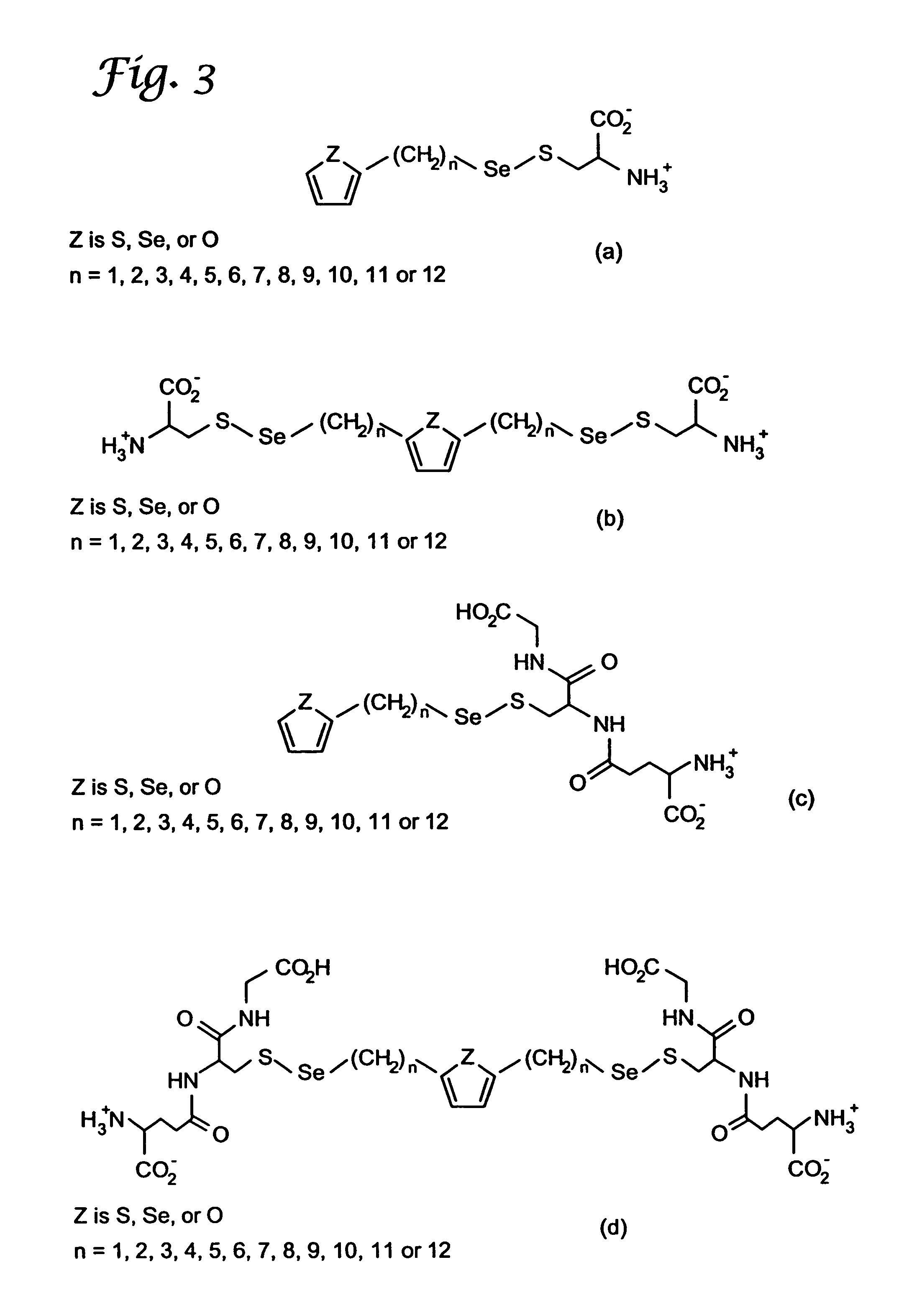Organoselenium compounds for cancer chemoprevention
a technology of organoselenium compounds and cancer, applied in the direction of peptides, drug compositions, peptides, etc., can solve the problem of excess selenium, and achieve the effect of slowing down the metabolism of the ring moiety and enhancing the chemopreventive
- Summary
- Abstract
- Description
- Claims
- Application Information
AI Technical Summary
Benefits of technology
Problems solved by technology
Method used
Image
Examples
example 1
Synthesis of Thienyl-2,5-di-methyleneselenocyanate (TDMSC)
[0073]
[0074]The starting compounds, thiophene, chloromethylether, acetic acid, and phosphoric acid, were purchased from Aldrich Chemical Company (Milwaukee, Wis.). The intermediate 2,5-thienylbis(methylene)chloride was synthesized by stirring thiophene (0.24 mol) with chloromethyl methyl ether (0.65 mol), in acetic acid (140 ml) in the presence of phosphoric acid (25 ml) at room temperature for 15 hours. The reaction mixture was poured into (500ml) ice-water, and the product was extracted with diethyl ether. The ether layer was washed with water and dried with anhydrous magnesium sulfate. The solvent was removed under reduced pressure and the product was used in the next step without further purification. TDMSC 2 was prepared by modification of the procedure of El-Bayoumy et al., Cancer Res. 52:2402–2407 (1992). To a suspension of KSeCN in dry acetone stirred under nitrogen atmosphere, a solution of 2,5-thienylbis(methylene)c...
example 2
Synthesis of 2-Thienylmethyleneselenocyanate (TMSC)
[0075]
[0076]Methylthiophene was purchased from Aldrich Chemical Co., (Milwaukee, Wis.). The starting compound 2-bromomethylthiophene was prepared as described in Pampalone et al., Org. Pre. and Procedures 1:209–212 (1969). A mixture of methylthiophene and N-bromosuccinamide in carbon tetrachloride, in the presence of 2,2′-azobisisobytyronitrile as a catalyst was refluxed for 3 h, under nitrogen atmosphere. After workup, 2-bromothiophene was purified by distillation under reduced pressure. TMSC 1 was synthesized by following the procedure used for TDMSC 2 described above. The purity and structures of the intermediate and final compounds were confirmed by 1H NMR and CI-MS. See data in Table 1.
example 3
Synthesis of Selenophenyl-2,5-di-methyleneselenocyanate (SDMSC)
[0077]
[0078]The starting compounds, selenophene, chloromethyl ether, acetic acid, and phosphoric acid, were purchased from Aldrich Chemical Company (Milwaukee, Wis.). The intermediate, 2,5-selenophenylbis(methylene)chloride was synthesized by stirring selenophene (0.24 mol) with chloromethyl methyl ether (0.65 mol) in acetic acid (140 ml) in the presence of phosphoric acid (25 ml) at room temperature for 15 hours. The reaction mixture was poured into (500 ml) ice-water, and the product was extracted with diethyl ether. The ether layer was washed with water and dried with anhydrous magnesium sulfate. The solvent was removed under reduced pressure and the product was used in the next step without purification.
[0079]The procedure used to make SDMSC 4 was similar to that used to synthesize TDMSC from 2,5-thienylbis(methylene)chloride described above in Example 1. The purity of the intermediate and the final product was confi...
PUM
| Property | Measurement | Unit |
|---|---|---|
| flow rate | aaaaa | aaaaa |
| volume | aaaaa | aaaaa |
| volume | aaaaa | aaaaa |
Abstract
Description
Claims
Application Information
 Login to View More
Login to View More - R&D
- Intellectual Property
- Life Sciences
- Materials
- Tech Scout
- Unparalleled Data Quality
- Higher Quality Content
- 60% Fewer Hallucinations
Browse by: Latest US Patents, China's latest patents, Technical Efficacy Thesaurus, Application Domain, Technology Topic, Popular Technical Reports.
© 2025 PatSnap. All rights reserved.Legal|Privacy policy|Modern Slavery Act Transparency Statement|Sitemap|About US| Contact US: help@patsnap.com



